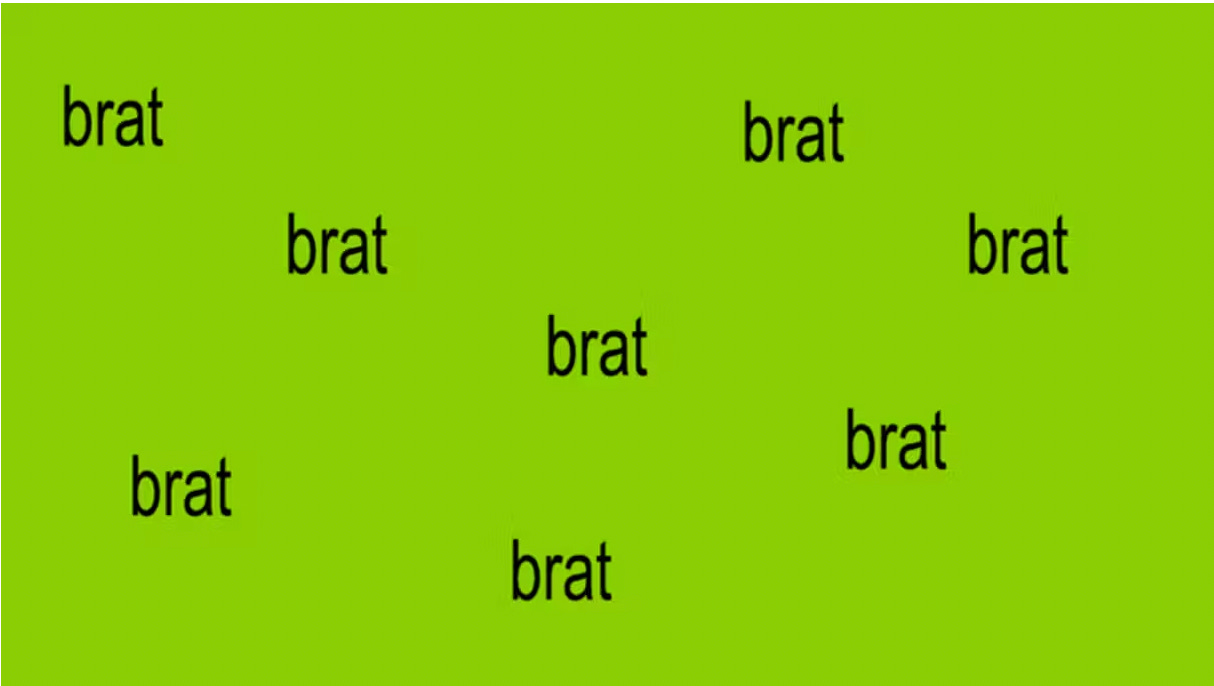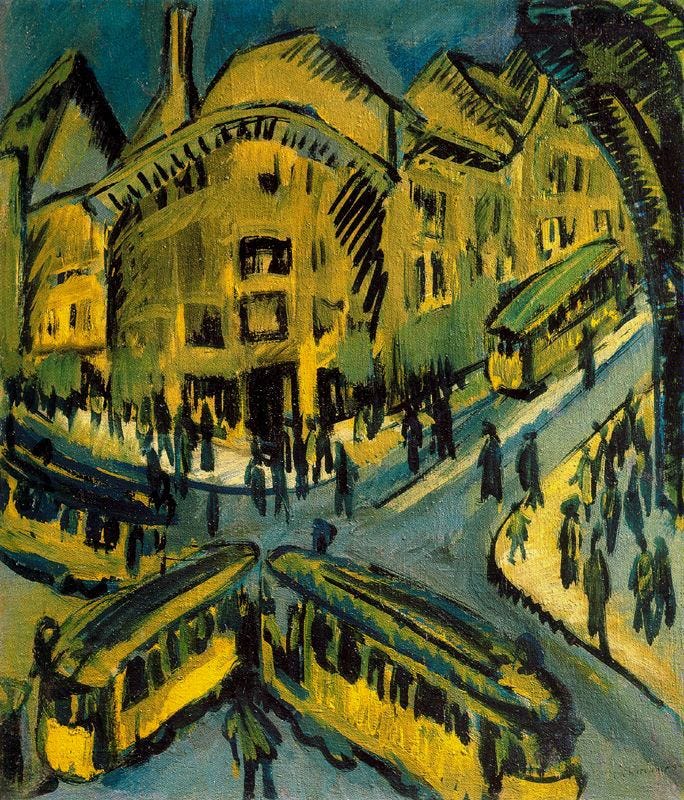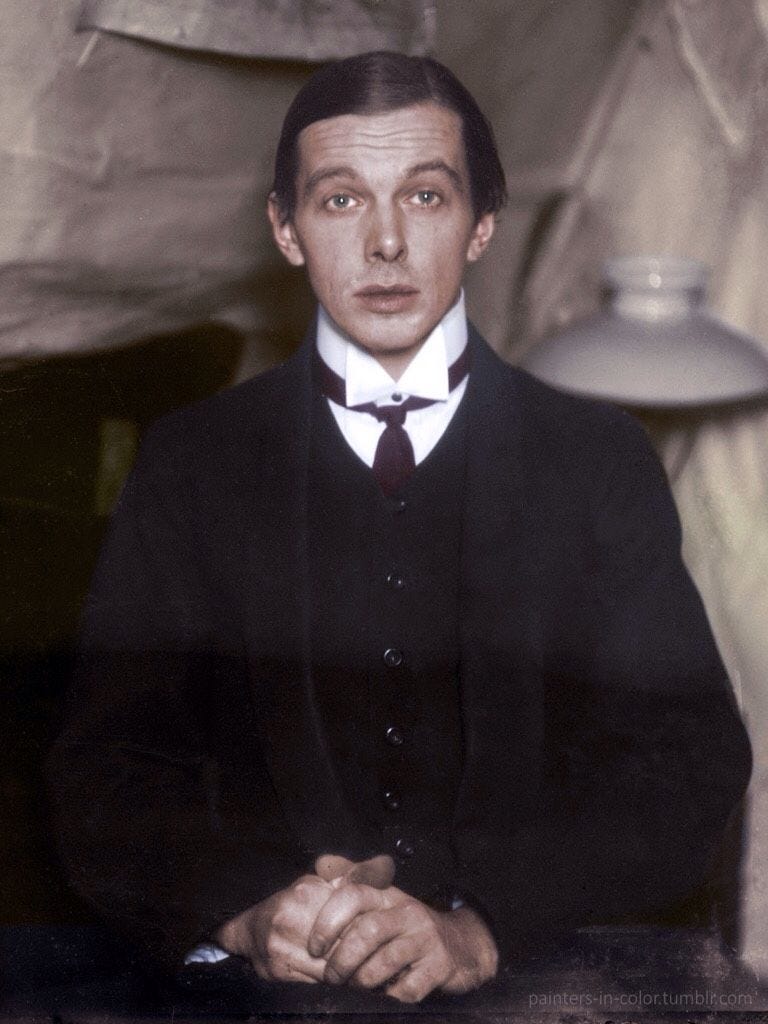Someone once told me they expected me to always be ‘in the know’ when it came to pop culture. I think of this as a compliment because it shows I’m passing as a normal human being when in fact I’m actually a time traveling alien vampire in disco pants. In reality, I’m utterly clueless about pop culture. I’ve long let go of the notion that I need to be ‘in the know’ on pop culture, that my time is better suited elsewhere.
I honestly can’t name a single song that has come out. If you ask me to name a Taylor Swift song from the last five or so years…. Yeah no. I think she wrote a new one called The Dead Poets Society? I think people are mad about her being called gothic? I don’t know, and I don’t want to know.
Let me be ignorant on these things. The most exciting pop culture thing I’ve learned recently is that Edgar Allan Poe met Charles Dickens in Philadelphia. Hell, if anyone is ‘brat,’ it’s Edgar Allan Poe.
But we talk about art here. Naturally ‘brat green’ has been everywhere despite my attempts to evade pop culture and thereby remain in my blissful jazz loving book reading world, and my brain made a quick connection. I kept waiting for someone to write about art that is ‘brat green’ and started to debate what would be the painting in question, and the answer hit me like a bolt. And then I realized with dread that I was going to write about brat green art. So here we are, talking about a color associated with a singer I can’t name a single song of because my brain made a connection.
Familia, nothing is more brat than German Expressionism.

When people think German Expressionism they tend to think of film, which is completely fair. I’ve never sat down and watched a German Expressionist film, only stared at images of the sets online, and I’m mesmerized. Perhaps it’s my endless obsession with Kafka, but I suspect German Expressionist films would scratch the itch left behind by The Trial.
What I’m talking about is a group of German artists who formed their own movement in 1905 and called themselves Die Brücke, or The Bridge. The name was inspired by Nietzsche after he wrote that, “what is great in man is that he is a bridge and not a goal.” The intent of these artists was to move the German art world away from the old academy and launch a modern world focusing on depictions of emotion and their current state of Germany.
Their manifesto read: “Whoever renders directly and authentically that which impels him to create is one of us.”
Among those German artist that came together to form The Bridge in 1905 was Ernst Ludwig Kircher, Erich Hecel, Fritz Bleyl, and Karl Schmidt-Rottluf. They wanted to create art that was purely ‘German.’ They wanted something unique to their country and their experiences. The group met as students in architecture school, witnessing the quick changes to their 20th century world, but chose to pursue a form of art that, while new, focused on painting and printmaking. Folk art inspired much of their work. But, most importantly, their work was about the emotions of the human rather than logic. They’re perhaps most closely linked to the Fauves.
Ernst Ludwig Kirchner is perhaps one of the most tragic figures of 20th Century German art. As is natural, the moment we hear ‘20th Century Germany’ our minds immediately go to WWII. Sure, all of this info about The Bridge sounds wonderful, but we all know what’s coming for them.
Kirchner was born on May 6, 1880 in Aschaffenberg, Bavaria, Germany. In 1901 he enrolled at the Dresden Technical High School where he gained an interest in art. As we mentioned, he became friends with other art students and formed The Bridge, but they would go on to disband in 1913. By 1911, Kirchner moved to Berlin and found his new subject: the city life. His particular interest was in prostitutes, whom he saw as vital symbols of Berlin.
In 1914, the Great War began, and Kirchner joined the German army. His time there was short lived as he suffered a nervous breakdown and terrible health. He was discharged, and continued to suffer with his health but pushing forward with his art. He moved to Davos, Switzerland in 1917, turning his attention to landscapes. He had multiple major exhibitions in Berlin and Frankfurt in the 1920s, and was quickly rising in acclaim. In 1931, Kirchner was made a member of the Prussian Academy.
It seemed as though the German Art he wanted to originate was gaining traction. Or, it would have, were it not for the inevitability of German politics in the 1930s.
It should come as no surprise that a man who painted prostitutes and refused to aim for realism but instead use color and light as a symbol of emotions would be labled as ‘degenerate’ by the Nazis. In 1937, more than 600 of his works were confiscated from German museums. Many were either destroyed or sold, those that were sold were sent to America
In that same year, 32 of his works were featured in an exhibition of Degenerate Art presented by the Nazis to allow ridicule of the artists shown. Kirchner was also forced to give up his seat in the Berlin Academy of Artists. When the Nazi occupation neared his home in Switzerland, the pain of having his work deemed ‘un-German’ seemed to have caused severe psychological damage. In 1938, Kirchner committed suicide. The final years of his life were filled with drug abuse an alcoholism as he watched his country fall under the influence of the Nazis.
I realize writing about an artist who ended his life after the Nazi’s destroyed his life work is morbid and seemingly unfitting for a post using a color from a British pop album to discuss said art. Except, as many know, brat green has now been attributed to the American political sphere. Kamala Harris IS brat.
I’m not here to make a political commentary because like many news anchors, I have no idea what ‘brat’ even means in connection to Kamala Harris. I’m not even sure if the singer in question can even vote in American politics. Isn’t Charlie XOXOXO Gossip Girl a British citizen?
I realize Kirchner’s story is tragic, and it would be wrong to dance around that, but I don’t want to get too lost in that heaviness. I want to celebrate his work. And I want to celebrate his use of the color green. Green is a constant in the work of Kirchner. He paints with a sort of neon green that we can’t really call ‘brat green’ as color mixing was a whole different ball game in those days. But it’s still striking.
For Kirchner, color is as much the subject as the people and setting he’s depicting. In some ways, his use of color is akin to Matisse and the fauves, namely of the infamous portrait Matisse painted of his wife. But there’s also a clear juxtaposition in use here. Kirchner uses green, a color synonymous with the natural world, in his city scapes.
He paints prostitutes, the buzz of Berlin, and the rampant ever changing world around him. And there is green, a color that seems to say ‘slow down’ and ‘take your time’ the way nature does, a color not often found in cities. There’s a hedonistic edge to his work - again, prostitutes abound - but painted with the graceful color of the earth. He’s not painting them as gaudy or brash per say, which would call upon reds, but in green. Beautiful, elegant, natural green.
I most adore his painting of a female artist in 1910. I’ve shared it before in notes but it always amazes me with how modern it feels. You’d think this were painted just yesterday, or a few years ago. This could easily be a painting depicting a girl in deep contemplative boredom while in lockdown. It’s bafflingly modern, and I’m always taken with it.
That Kirchner feels contemporary isn’t strange. I’m always fond of linking older artists to our contemporary world, but the root of his work isn’t about the historical shifts in that day and age. Rather, Kirchner is seeking out the root of humanity in what felt to him like an ever-changing world. This painting doesn’t feel new just because of what she’s wearing, but because we know exactly what she’s feeling in this moment because we’ve been in her shoes.
In such simple strokes Kirchner is able to perfectly capture the emotions of this lonely woman. Much of his subjects are lonely. Kirchner stands as Germany’s own Edward Hopper (or is it that Hopper is America’s Kirchner?) as well as Germany’s own Matisse. Perhaps we could say he’s Germany’s own Gabriel Garcia Marquez as well.
In fact, Kirchner’s subjects are often in a state of disillusionment or loneliness. They aren’t fully interacting with their busy world, nor are they interacting with any of the people they surround themselves with. It’s rare that his subjects do interact, in which case we the viewer are the lonely ones. We stand in on an intimate moment, catching ourselves with a start as we realized we’re witnessing something we’re not supposed to see.
Last year, amid the excitable chaos that was Barbenheimer, Barbie Pink was all the rage. Everyone I knew was sharing ideas and going back and forth over where to find the perfect Barbie Pink shoes or outfit. My coworker and I both realized we picked out the same pink heels to wear to the film.
That color can be cultural isn’t necessarily new or groundbreaking, but that it can be a short lived trend is something else entirely. Brat Green and Barbie Pink are not the asme as Tiffany Blue, a color that is known and connected to a brand and has remained so for many many years. And it will continue to be so. But, like Barbie Pink, Brat Green will go away. Several years ago ‘sea foam green’ or ‘mint green’ was all the rage, especially when paired with ‘coral pink’ (or ‘coral tomato’ as we liked to call it in my family). Where are those colors now? They feel dated, tacky.
Art, in comparison, is outside of the world of color branding and fashion trends. The fashion world shifts every couple of years between neutrals and bold colors. Art doesn’t do this. Even Rothko’s use of art cannot touch the word ‘trendy.’ Yves Klein’s blue paintings were not a trendy choice, but a form of expression. So when we understand that color in art is not the result of branding or fashion trends, that leaves only the possibility that color in art is pure expression.
This brings me to my final thought on the work of Kirchner. We know the general reaction to the French Fauves (it’s literally in the name), and of course, I just shared how the Nazi’s reacted to Kirchner’s work. I don’t think it’s the portrayal of prostitutes that offended the Nazi’s. I think it’s the uncomfortable nature of colors as emotional expression.
Kirchner and his fellow artists were trying to create a form of art that was ‘truly German.’ This was also what the Nazi’s were attempting to do, though in a much more egregious manner. They wanted to create a sense of national pride, but determined that Kirchner’s paintings were not only ‘degenerate’ but ‘not German enough.’
It’s heartbreaking to think that such gorgeous art, art that is so alive and vivacious, could be deemed ‘not enough’ in anyone’s eyes, let alone the very country it sought to exemplify. But then, isn’t it uncomfortable? Feelings are uncomfortable. The sheer magnitude of what we as humans can feel is wretched. There is something so unbearable about having feelings so much so that many of us wish to suppress them as much as possible. And if we must feel, it must always be good things. It mustn’t be complicated. It mustn’t be bad feelings. We want freedom from feelings. Correction, we want freedom from bad feelings.
But those wretched uncomfortable unbearable feelings are what make us human. They are so part of our humanity that when we look at Kirchner’s work and see how he displays us in our bare bones, we cannot help but want to hide some part of ourselves away. This isn’t just Kirchner who does this, many artists are guilty of forcing us to confront ourselves. That’s part of what makes art so incredible, the way it reveals ourselves to us.
So no, I’m not surprised the Nazi’s wanted to shield themselves from this art. Only cowards would want to look away from Kirchner. Only cowards want to hide away their feelings. And only those strong and sensitive to the incredible journey that is being human can do what Kirchner did.
I wish Kirchner could have outlived the war and gone on to see how his work continued to influence his native Germany. Ernst Ludwig Kirchner is considered to be one of the most important painters of 20th Century Germany. Despite what seems to be a criticism of Berlin and the rapidly growing world, I suspect he loved his country once upon a time, and watching his home become degenerate at the hands of the Nazis must have been overwhelming. I wish I could tell him that he did it, that he created a work of art that was the spirit of Germany.












You’re right about “Female Artist.” It could have been painted yesterday. Do you know his self-portraits? In a particularly harrowing one, he wears his military uniform and is missing a hand.
I was afraid to click into this one because I really don't have a clue what brat is, but damn it was worth it. Beautiful write-up and thank you for showing me Kirchner works that I had never seen before.